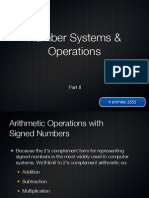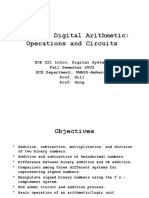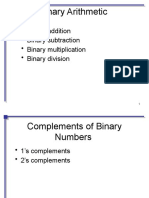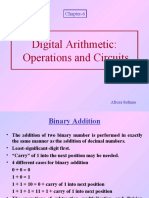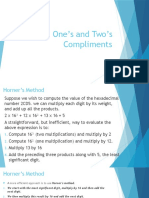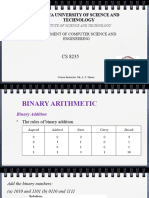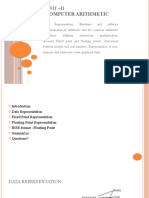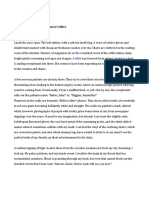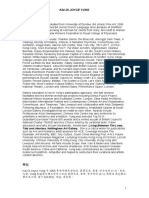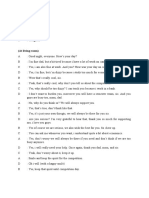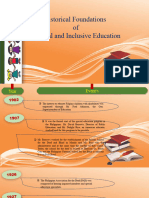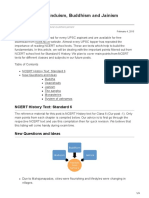Number Systems &
Operations
Part II
�Arithmetic Operations with
Signed Numbers
Because the 2s complement form for
representing signed numbers is the most
widely used in computer systems. Well
limit to 2s complement arithmetic on:
Addition
Subtraction
Multiplication
Division
�Addition
4 cases that can occur when 2 signed
numbers are added:
Both numbers positive
Positive number with magnitude larger than
negative number
Negative number with magnitude larger than
positive number
Both numbers negative
�Addition
Both numbers positive:
ex:
00000111
+00000100
00001011
7
+4
11
The sum is positive and is therefore in true
(uncomplemented) binary.
�Addition
Positive number with magnitude larger
than negative number:
ex:
00001111
15
+11111010
+6
00001001
9
Discard1
carry
The final carry bit is discarded. The sum is
positive and is therefore in true
(uncomplemented) binary.
�Addition
Negative number with magnitude larger
than positive number:
ex:
00010000
+11101000
11111000
16
+24
8
The sum is negative and therefore in 2s
complement form.
�Addition
Both numbers negative:
ex:
11111011
5
+11110111
+9
Discard1
11110010
14
carry
The final carry bit is discarded. The sum is
negative and therefore in 2s complement
form.
�Addition
Remark:
The negative numbers are stored in 2s
complement form so, as you can see, the
addition process is very simple: Add the two
numbers and discard any final carry bit.
�Addition
Overflow condition:
When two numbers are added
and the number of bits
required to represent the sum
exceeds the number of bits in
the two numbers, an overflow
results as indicated by an
incorrect sign bit.
An overflow can occur only
when both numbers are + or -.
ex: 01111101
+00111010
10110111
Magnitude
incorrect
Sign
incorrect
125
+58
183
�Addition
Numbers are added two at a time:
Computer add strings of numbers two
numbers at a time.
ex: add the signed numbers: 01000100, 00011011, 00001110, and
00010010
68
01000100
+27
+00011011
Add1sttwonumbers
95
01011111
1stsum
+14
+00001110
Add3rdnumber
109
01101101
2ndsum
+18
+00010010
Add4thnumber
127
01111111
Finalsum
�Subtraction
Subtraction is a special case of addition.
Subtraction is addition with the sign of the
subtrahend changed.
The result of a subtraction is called the
difference.
The sign of a positive or negative binary is
changed by taking its 2s complement.
_______________________________
Subtrahend = , Minuend =
�Subtraction
Since subtraction is simply an addition
with the sign of the subtrahend changed,
the process is stated as follows:
To subtract two signed numbers, take the 2s
complement of the subtrahend and add.
Discard any final carry.
�Subtraction
ex: Perform each of the following subtraction of the signed numbers:
(a)0000100000000011
(b)0000110011110111
(c)1110011100010011
(d)1000100011100010
(a)00001000
+11111101
100000101
8
+3
5
(b)00001100
+00001001
00010101
(c)11100111
+11101101
111010100
25
+19
44
(d)10001000120
+00011110+30
1010011090
12
+9
21
�Hexadecimal and Octal
Numbers
�Hexadecimal Numbers
We will call it for short as hex.
It has 16 characters. Digits 0-9 and letters
A-F.
It used primarily as a compact way of
displaying or writing binary numbers since
it is very easy to convert between bin and
hex.
Hex is widely used in computer and
microprocessor applications.
�Hexadecimal Numbers
Decimal
Binary
Hexadecimal
0000
0001
0010
0011
0100
0101
0110
0111
1000
1001
10
1010
11
1011
12
1100
13
1101
14
1110
15
1111
�Hexadecimal Numbers
If you see h mixing in numbers (in the
context of computer systems), please note
that its most likely that the numbers are
hexadecimal numbers. (Be careful. h is
not one of A-F using in hex).
For example
16h=000101102
0Dh=000011012
�Hexadecimal Numbers
Bin-to-Hex Conversion
Simply break the binary number into 4-bit
groups, starting at the right-most bit and
replace each 4-bit group with the equivalent
hex symbol.
(a)1100101001010111
(b)111111000101101001
1100101001010111
00111111000101101001
CA57
=CA5716
3F169
=3F16916
�Hexadecimal Numbers
Hex-to-Bin Conversion
Reverse the process (of bin-to-hex) and
replace each hex symbol with the appropriate
four bits.
ex: Determine the binary numbers for the following hex numbers:
(a)10A4h
(b)CF8Eh
10A4 CF8E
(c)9742h
9742
0001000010100100 11001111100011101001011101000010
�Hexadecimal Numbers
Hex-to-Dec Conversion
2 methods:
Hex-to-Bin first and then Bin-to-Dec.
Multiply the decimal values of each hex digits by its
weight and then take the sum of these products.
�Hexadecimal Numbers
Hex-to-Dec Conversion
Hex-to-Bin first and then Bin-to-Dec
ex: Convert the following hex numbers to decimal:
(a)1Ch
1Ch=00011100=16+8+4=2810
(b)A85h
A85h=101010000101=2048+512+128+4+1=269310
�Hexadecimal Numbers
Hex-to-Dec Conversion
Multiply the decimal values of each hex digits by its
weight and then take the sum of these products.
ex: Convert the following hex numbers to decimal:
(a)E5h
E5h=(Ex16)+(5x1)=(14x16)+5=224+5=22910
(b)B2F8h
B2F8h=(Bx4096)+(2x256)+(Fx16)+(8x1)
=(11x4096)+(2x256)+(15x16)+(8x1)
=45,056+512+240+8=45,81610
�Hexadecimal Numbers
Dec-to-Hex conversion
Repeated division of a dec number by 16
ex: Convert the dec number 650 to hex
LSD
650/16 = 40.625
0.625x16 = 10 = A
40/16 = 2.5
0.5x16
2/16 = 0.125
0.125x16 = 2 = 2
Stop when whole
number quotient is
ZERO.
=8 =8
Hence 65010 = 28Ah
MSD
�Octal Numbers
Like the hex, the oct provides a convenient
way to express binary numbers and codes. (but,
its not as commonly used as hex).
8 digits: 0-7
0,1,2,3,4,5,6,7,10,11,12,13,14,15,16,17,20,
Operations we learn about hex so far work the
same way on oct just mark this:
Hex = 4 binary bits
Oct = 3 binary bits
Now, lets crack the following exercises
�Octal Numbers
Bin-to-Oct Conversion
(a)110101 (b)101111001
(c)100110011010 (d)11010000100
Oct-to-Bin Conversion
(a)138(b)258(c)1408(d)75268
Oct-to-Dec Conversion
(a)23748
Dec-to-Oct Conversion
(a)35910
